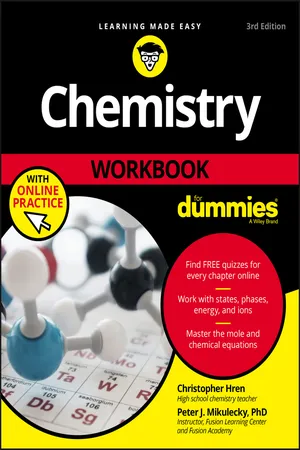
- English
- ePUB (mobile friendly)
- Available on iOS & Android
Chemistry Workbook For Dummies with Online Practice
About this book
Take the confusion out of chemistry with hundreds of practice problems
Chemistry Workbook For Dummies is your ultimate companion for introductory chemistry at the high school or college level. Packed with hundreds of practice problems, this workbook gives you the practice you need to internalize the essential concepts that form the foundations of chemistry. From matter and molecules to moles and measurements, these problems cover the full spectrum of topics you'll see in class—and each section includes key concept review and full explanations for every problem to quickly get you on the right track. This new third edition includes access to an online test bank, where you'll find bonus chapter quizzes to help you test your understanding and pinpoint areas in need of review. Whether you're preparing for an exam or seeking a start-to-finish study aid, this workbook is your ticket to acing basic chemistry.
Chemistry problems can look intimidating; it's a whole new language, with different rules, new symbols, and complex concepts. The good news is that practice makes perfect, and this book provides plenty of it—with easy-to-understand coaching every step of the way.
- Delve deep into the parts of the periodic table
- Get comfortable with units, scientific notation, and chemical equations
- Work with states, phases, energy, and charges
- Master nomenclature, acids, bases, titrations, redox reactions, and more
Understanding introductory chemistry is critical for your success in all science classes to follow; keeping up with the material now makes life much easier down the education road. Chemistry Workbook For Dummies gives you the practice you need to succeed!
Frequently asked questions
- Essential is ideal for learners and professionals who enjoy exploring a wide range of subjects. Access the Essential Library with 800,000+ trusted titles and best-sellers across business, personal growth, and the humanities. Includes unlimited reading time and Standard Read Aloud voice.
- Complete: Perfect for advanced learners and researchers needing full, unrestricted access. Unlock 1.4M+ books across hundreds of subjects, including academic and specialized titles. The Complete Plan also includes advanced features like Premium Read Aloud and Research Assistant.
Please note we cannot support devices running on iOS 13 and Android 7 or earlier. Learn more about using the app.
Information
Getting Cozy with Numbers, Atoms, and Elements
Noting Numbers Scientifically



Using Exponential and Scientific Notation to Report Measurements
Table of contents
- Cover
- Title Page
- Table of Contents
- Introduction
- Part 1: Getting Cozy with Numbers, Atoms, and Elements
- Part 2: Making and Remaking Compounds
- Part 3: Examining Changes in Terms of Energy
- Part 4: Swapping Charges
- Part 5: The Part of Tens
- About the Authors
- Connect with Dummies
- End User License Agreement